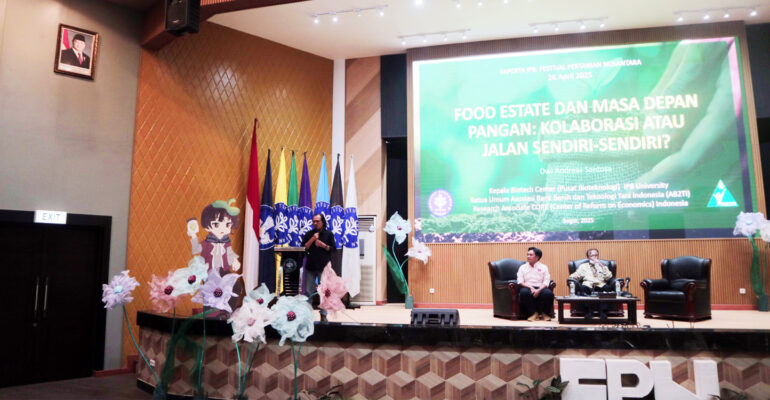Avoid Repeating Past Failures: IPB University Professor Highlights Challenges and Solutions for Food Estate Development

IPB University Professor, Prof Dwi Andreas Santosa, revealed that Indonesia’s food estate efforts over the past quarter-century have consistently faced failure. According to him, this series of failures is closely linked to a range of significant challenges.
Failed food estate programs include the 1,4 million hectares Peatland Development Project (PLG) (1996), the 1,23 million hectares Merauke Integrated Food and Energy Estate (MIFEE) (2008), the 300.000 hectares Bulungan Food Estate (2013), the 100.000 hectares Ketapang Food Estate (2013), and the 1,2 million hectares Rice Estate (2015).
Prof Dwi Andreas explained that one of the main challenges is Indonesia’s dependence on rice imports reaching up to 2 million tons per year following the end of rice self-sufficiency in 1993. In addition, the large-scale conversion of agricultural land to non-agricultural uses reaching up to 1 million hectares has posed another major obstacle to food estate implementation.
“The government’s failure to fulfill the four pillars of food land development has also contributed to the failure of food estate initiatives,” he stated during the 2025 Nusantara Agriculture Festival (FPN) Seminar titled “Food Estate and the Future of Food: Collaboration or Going Solo?” held by the Department of Agronomy and Horticulture (AGH) at IPB University (4/26).
As Chairman of IPB University’s Biotech Center, he explained that the four pillars consist of land and agro climatic feasibility, technological feasibility, infrastructure feasibility, and socio-economic viability.
Nevertheless, Prof Andreas also offered several recommendations for the successful implementation of food estates. “Policies related to food estates must be based on real, field-validated data,” he emphasized.
First, he proposed expanding agricultural land by utilizing small, currently unused plots an essential step given the significant rate of land conversion from agricultural to non-agricultural uses.
Second, he urged the government to establish “The Outline of State Policy (GBHN)” specifically for food estate development. Regardless of who is president, a designated food estate region must be consistently developed until it succeeds.
“Of all the available options, the former 1 million hectare PLG site is the most suitable for this purpose,” he noted.
Furthermore, smaller areas within the former PLG site that meet the criteria of the four development pillars should be continuously cultivated and developed to become “acupuncture points” that stimulate broader agricultural development in surrounding regions.
Despite past failures and ongoing challenges, Prof Munif Ghulamahdi, another professor from the Department of Agronomy and Horticulture, emphasized that Indonesia still holds significant potential to realize successful food estates.
One such potential lies in the availability of tidal land, totaling 20,1 million hectares, with 9 million hectares deemed suitable for agricultural activities. This potential has been demonstrated through successful ABGC (academic, business, government, and community) collaboration.
This collaboration led to the development of 50 hectares of cornfields during 2023 and 2024. The project, carried out on tidal land, is projected to expand to 500 hectares by 2025.
“The utilization of tidal land through integrated Saturated Water Cultivation (Budidaya Jenuh Air/BJA) presents a promising opportunity for future food estate success,” he stated confidently.
It is undeniable that food estate implementation requires a holistic approach to improve the chances of success. Prof Suryo, Dean of the Faculty of Agriculture at IPB University, emphasized that food estates cannot rely on a single factor; other elements such as soil health, technology, and human resources are also crucial.
This sentiment was echoed by the Chairman of the Department of Agronomy and Hrticulture at IPB University.
“Food estate is a major undertaking it cannot succeed if pursued in isolation,” he concluded. (*/Rz)(IAAS/RWA)



